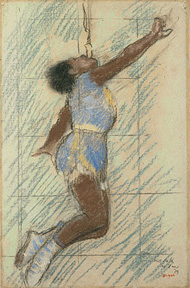|
This exhibition brings together the Getty Museum's 14 artworks by the late-19th-century French artist Edgar Degas. These paintings, drawings, and photographs highlight three themes that occupied Degas throughout his career: portraits, bathers, and scenes from modern life.
As a group, these works show Degas to be the most modern and most traditional of artists: modern in presenting new subjects from dramatic viewpoints and with penetrating psychological insight; traditional in his concern with the fundamental challenges of making art—depicting figures in space, capturing light and shadow, and mastering his materials. The drawing of Miss Lala at the Fernando Circus is a study for a painting depicting a circus performer hoisted to the circus rafters by a rope held in her teeth. Degas suggested her iridescent costume with layers of yellow and purple and smudged black pastel for her hair. Squares drawn over the composition allowed Degas to transfer the image to another sheet of paper.
|
 |
|
When he made this striking self-portrait, Degas was about 23 years old. He was at the midpoint of a three-year sojourn in Italy, where he visited his father's extended family while studying art in Rome and Florence.
The young artist's expression suggests both seriousness and hesitation, and it reflects his state of mind during the early part of his career. Letters from his relatives at this time mention his obvious talent and potential as well as his self-doubt. His father wrote, "my dear Edgar, you have no reason to go on tormenting yourself, you are on the right track."
|
 |
|
From about 1882 to 1886 Degas created several pictures of women in hat shops. Some depict the customers; others show milliners at work, as in this painting. Here, three monochromatic hat forms in the foreground seem to observe the brightly lit figure absently folding a pink ribbon and the shadowed figure pinning a ribbon into place.
Degas kept this painting in his studio for years and continually revised it, radically changing the original subject. X-ray analysis reveals that the woman at left wore a much more elaborate costume, indicating that Degas had originally portrayed her as a customer.
|
 |
|
Degas may have made this photograph to spare his model from holding this pose long enough for him to sketch it. A friend visiting the studio noted, "the right shoulder, bearing the weight of the body, takes a most unexpected shape, which suggests some kind of acrobatic activity of violent effort."
Degas later based a painting on this photograph. His technique as both a painter and a draftsman is emulated in the beautiful shadow on the model's spine and the rhythmic contours of her torso, echoed in the dark folds of the towel.
|
 |
|
The theme of the female nude dominated Degas's late work. In his bather subjects he experimented with highly artificial poses, exploring the formal possibilities of presenting a figure in an interior space. The uncomfortable position depicted in this canvas allowed him to emphasize the body's linear and angular qualities, demonstrated by the bent arm and the leg propped on the bathtub.
Degas also experimented with his technical approach, creating a rough, layered surface—sometimes even using his fingers to manipulate the paint. Despite their originality and modernity, Degas clearly understood his bathers as being part of a long artistic tradition. He mused that had he lived in an earlier century, he would have painted biblical or mythological subjects featuring female nudes.
The exhibition is located at the Getty Center, Museum, North Pavilion.
|
 |





